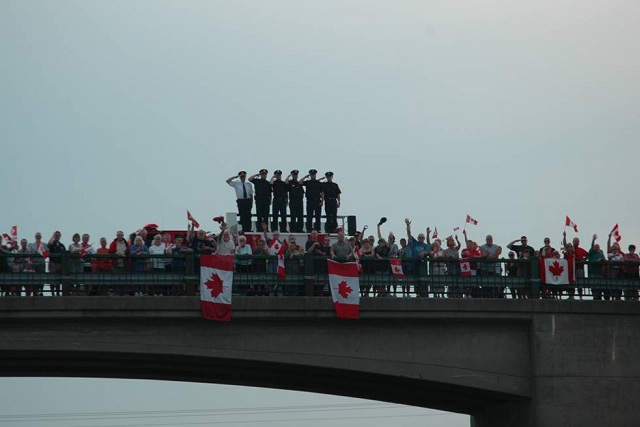At HomeAvid Reader
Author captures the love story behind Highway of Heroes
By Laura Earl
Book Review: “Highway of Heroes: True Patriot Love” By Pete Fisher
Many of us have driven on Canada’s largest highway, the 401, to go see a friend or family, maybe passing through on your way to the West or the East, or maybe it’s your daily commute. Up until 2002, this 172 km stretch from Trenton to Toronto was just a simple track of asphalt, a series of on and off ramps and overpasses that allowed the flow of traffic to continue in our busy lives. If you were driving on a hot summer weekend trying to leave the city of Toronto heading east to your cottage in the Kawarthas, you may have found this the most frustrating stretch of highway you’ve ever been on. Jammed, bumper to bumper, everyone is in a hurry to get to their destination, muttering about the aggravation of not getting where you wanted to go fast enough.
 However, in April of 2002, this stretch of the 401 became something different. One day that month, a small group of community members transformed this strip of black-top from a simple roadway to a highway of heroes. It is the story of this journey that is so powerfully told in a new book by photo journalist Pete Fisher, titled Highway of Heroes: True Patriot Love.
However, in April of 2002, this stretch of the 401 became something different. One day that month, a small group of community members transformed this strip of black-top from a simple roadway to a highway of heroes. It is the story of this journey that is so powerfully told in a new book by photo journalist Pete Fisher, titled Highway of Heroes: True Patriot Love.
In a recent email exchange, Fisher explained the highway’s simple beginnings.
“The Highway of Heroes was started spontaneously by people watching the first fallen soldiers coming home [from Afghanistan] in April 2002,” wrote Fisher. “Residents along the highway, came out to the bridges after watching the [repatriation] ceremony live on television.”
“From such humble beginnings, this display of respect and grief,” Fisher says, “has grown to thousands of Canadians standing along the highway each time a soldier is brought home.” With a forward from currently serving Chief of Defense Staff General Walter Natynczyk, “Highway of Heroes” offers the average Canadian a thorough look at this phenomenal, grassroots display of patriotism.
Fisher tells me he never intended to write a book on the subject despite his close ties to the topic. He begins the 178 page glossy with the origins of the highway ceremony and how it started with a small group of locals and his own phone calls to area police and fire officials, standing on the highway overpasses between Trenton and Toronto, when the first four Canadian soldiers were repatriated. Fisher explains that because the soldiers’ remains must be autopsied by the Chief Coroner, each must make the two-hour journey from Canadian Forces Base Trenton to the Coroners’ offices in downtown Toronto.
Fisher does a thoughtful and compassionate job laying out this journey for the reader, describing events from a number of perspectives.
“Every story is one that I remember,” explains Fisher. ”You can’t help but be moved by what you are witnessing….the people lining each bridge, the repatriations at CFB Trenton.”
However, Fisher notes that it wasn’t until 2006, when 37 service personnel lost their lives in one year, that this outpouring of support by average Canadians started getting official recognition. This section of the MacDonald Cartier highway was not renamed until 2007, when a reporter for the Toronto Sun heard of another three deaths on his drive home from his cottage near Kingston.
 As veteran columnist Joe Warmington passed through this particular stretch of the 401, he recounts to Fisher in the book, he began brainstorming headlines for what he knew would be another outpouring of support for these most recent casualties. It was the phrase “highway of heroes” that struck him and became the front page headline over Fishers striking photograph of firefighters and regular Canadians saluting the hearses as they passed by. As Fisher explains in the book, “it was a passion project from there to get officials to mark the stretch of highway with its new moniker”.
As veteran columnist Joe Warmington passed through this particular stretch of the 401, he recounts to Fisher in the book, he began brainstorming headlines for what he knew would be another outpouring of support for these most recent casualties. It was the phrase “highway of heroes” that struck him and became the front page headline over Fishers striking photograph of firefighters and regular Canadians saluting the hearses as they passed by. As Fisher explains in the book, “it was a passion project from there to get officials to mark the stretch of highway with its new moniker”.
One of the things I found most fascinating in “Highway of Heroes” was the repeated use of the phrase “It’s just the right thing to do.” You read it again and again; from the man who took it upon himself to contact all of the businesses along that stretch of highway, asking them to lower their flags to half mast each time a soldier passed during their repatriation. Town councillors across the province and across the country passed resolutions to have a “Highway of Heroes” commemorative coin issued from the Royal Canadian Mint which is when Fisher hit a road block trying to make it happen. And then there’s the Toronto businessman who worked to find a flag from each soldier’s home town or province, to hang on the bridge he stands on and then sends that flag to the soldier’s family with a note saying it is from ‘an Anonymous Canadian Family’ in the hopes of letting them know that all Canadians are thinking of them.
The book also gives the reader a behind the scenes glimpse of the complexities of bringing our war dead home. Fisher turns to Captain Wayne Johnston, one of the Casualty Administration Officers, more commonly known as, repatriation officers. Johnston gives a step by step description of what’s involved , giving personal insights along the way. Its a process few Canadians are aware of, and perhaps, something of great value to the soldier’s family, to know the level of care that is taken in bringing these men and women home.
Fisher says he is trying to bring this experience to a wider audience. “I hope the rest of the country might realize in some small way, what if feels like to be standing along the Highway of Heroes.” He also hopes to raise awareness, using the closing pages to feature two charities geared towards helping Canadian service members and their families: ‘Wounded Warriors’ and ‘True Patriot Love’.
There are more than a few moments throughout the book which stir our emotions, perhaps none so strong as hearing from families of these fallen soldiers in their own words. Reading how much this outpouring of love and support has meant to them in their darkest hour; or how the commitment of so many people, strangers really, coming to that highway to salute their beloveds, affects them, is truly moving.
When I asked Fisher if he thinks this tradition will last past Canada’s role in Afghanistan he had this to say, “I hope, and I know it will continue past Afghanistan. When two fallen RCMP officers came home for the final time after dying in the Haiti earthquake, people lined the route, so I have no doubt it will continue.”
And what does he hope readers will take from this book? “The only message I could convey is how proud I am to live in the greatest country in the world. We have our differences in this country, but when one falls, we all grieve.”
I feel that this book should be a staple in every Canadian home. Through the stories and photos gathered in “Highway of Heroes: True Patriot Love”, Fisher has paid tribute to each and every soldier who has made that final journey home, and equally paid tribute to each and every person who has stood on those bridges to help them along the way.
Laura Earl is a journalist, writer, performer and military spouse currently living in Petawawa, Ontario.









